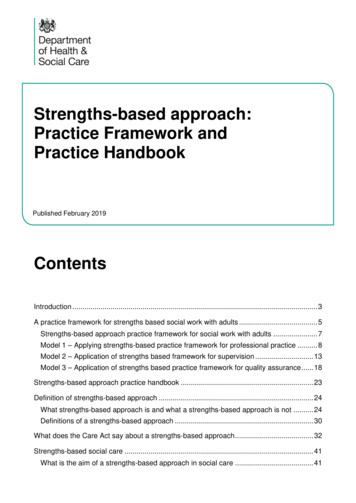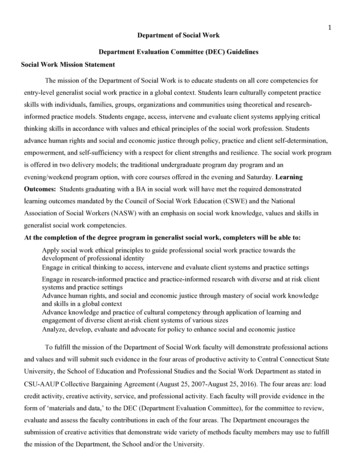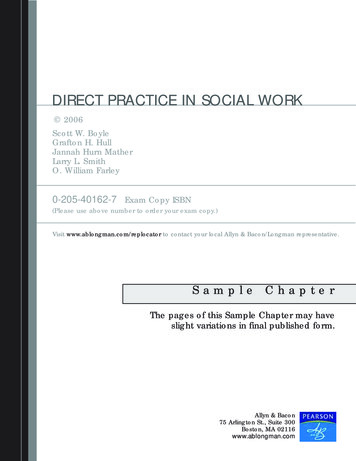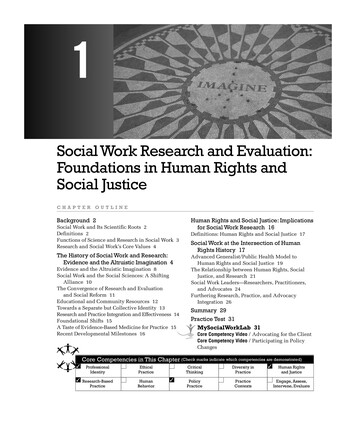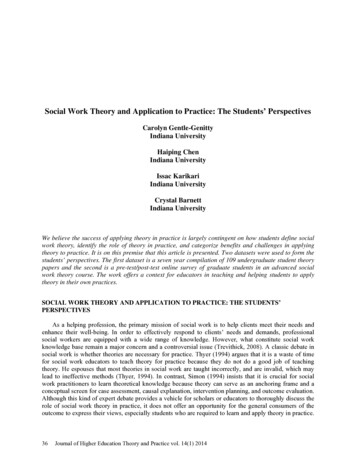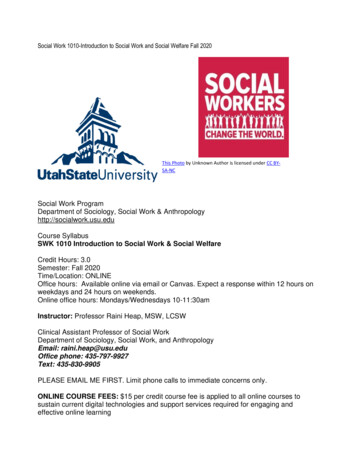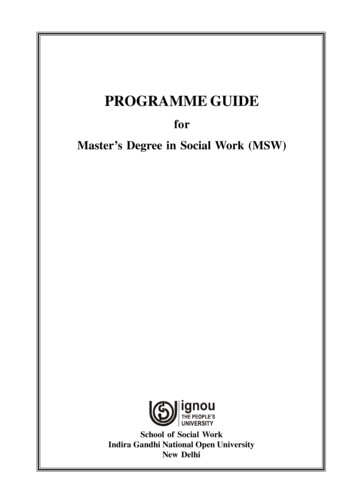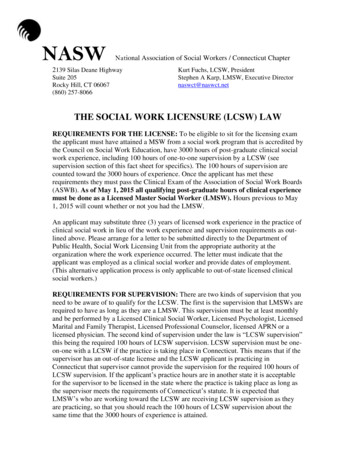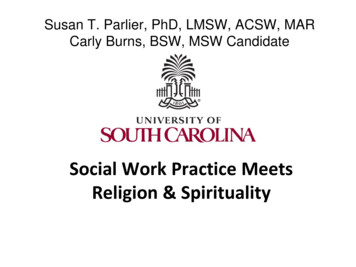
Transcription
Susan T. Parlier, PhD, LMSW, ACSW, MARCarly Burns, BSW, MSW CandidateSocial Work Practice MeetsReligion & Spirituality
Workshop Abstract Facilitator presents an overview of spirituality andreligion and their influence on social work practice. Participants gain an understanding, examination, andappreciation of faith, religion, and spirituality andtheir connections with other aspects of people’slives. Participants explore ways to include spirituality andreligion in the engagement, assessment,intervention, and evaluation processes.
Workshop Outcomes Understand diverse spiritual and religious definitionsand perspectives and their implications for socialwork practice Apply a practice framework of knowledge, values,and skills for a spiritually-sensitive social workpractice; and, Assess the impact and relevance of the socialworker’s personal religious/spiritual history on thesocial work helping process.
4TouchstonesRespectful Communications Guidelines by Eric H. F. Law R - Take Responsibility for what you say and feel without blamingothers E - Use Empathetic listening S - Be Sensitive to differences in communication styles P - Ponder what you hear and feel before you speak E - Examine your own assumptions and perceptions C - Keep Confidentiality – with all its various meanings discussed T - Trust ambiguity because we are not here to debate who is right or wrong Retrieved from www.kscopeinstitute.org/2007-02 Kaleidoscope Newsletter.pdf
Defining Religion“ institutional groups promulgate doctrine,beliefs, and practice important to manypeople (Dudley, 2016, p. 1).It is important to people’s spirituality because itprovides a major source of beliefs andpractice and provides a means for expression.Religion exist as an external entity (Dudley,2016, p. 1).
Defining Religion“Love, inner peace, and mystery are centralconcepts taught and practiced by religiousgroups” (Dudley, 2016, p. 7).Provides “a relationship with a Higher Powerand rules of morality and ethics are central tomany of their teachings (Dudley, 2016, p.7).Has Sacred Doctrines, Religious Beliefs, Religiousand Spiritual Practices
Defining SpiritualityDudley (2016) adopts the following definition:“A search for purpose and meaning in life, asense of connected with self, others, and theuniverse, and an ability to transcend ourimmediate experience to something largerknown by many to be a Higher Power beyondhuman power” (p. 40).
Global Spirituality & Religion Muslims are projected to be the world’s fastestgrowing major religious group in decades ahead. Christians have had a large share of the world’sdeaths (37%) because of the relatively advanced ageof some Christian populations. Religious “nones” are projected to decline as a shareof the world’s population. Hindus, Jews and adherents of folk will not keeppace with global population growth.Retrieved from The Changing Global Religious Landscape
United States Spirituality & Religion The Christian share of the U.S. population is declining,while the number of U.S. adults who do not identifywith any organized religion is growing across thecountry. The US remains home to more Christians than anyother country, and roughly 7 in 10 Americans identifywith some branch of the Christian faith. One of the most important factors in the decliningshare of Christians and the growth of the “nones” isgenerational replacement.Retrieved from America’s Changing Religious Landscape
South Carolina Spirituality & Religion Fewer people identify as white Christians(evangelical and mainline). Religiously unaffiliated has grown from 10% to 17%.(from 1 in 10 to almost 1 in 5) Shifts are being driven by racial and ethnic changes. Percentage of white residents went from 73% to61%. Black residents went from 19% to 25%.Hispanic residents went from 4% to 6%.Retrieved prris-american-values-atlas/
Statement of Need - SOWK MeetsSpirituality & ReligionIn U.S., the majority of the people who socialworkers contact within service delivery arelikely to be religious in some way(Ellor, Netting, & Thibault, 1999; Hodge, 2003;Pew Research Center, Religion and Public life,2015; as cited in Dudley, 2016).However, many people are non-religious andtheir spirituality is equally important and findsexpression in other ways.
Statement of Need - SOWK MeetsSpirituality & ReligionIn a qualitative study with people who had cancer,Taylor found seven spiritual need categories:1.2.3.4.5.6.7.The need to relate to an Ultimate Order;The need for positivity, hope, & gratitude;The need to give and receive love;The need to review beliefs;The need to have meaning;The need for religiosity;The need to prepare for death
The Ethics of Spiritually Sensitive PracticeNASW Code of Ethics “1.05 Cultural Competence and Social Diversity (a) Social workers should understand culture and itsfunction in human behavior and society, recognizingthe strengths that exist in all cultures. (b) Social workers should have a knowledge base oftheir clients’ cultures and be able to demonstratecompetence in the provision of services that aresensitive to clients’ cultures and to differencesamong people and cultural groups.
The Ethics of Spiritually Sensitive PracticeNASW Code of Ethics 05 Cultural Competence and Social Diversity (c)Social workers should obtain education about andseek to understand the nature of social diversity andoppression with respect to race, ethnicity, nationalorigin, color, sex, sexual orientation, gender identityor expression, age, marital status, political belief,religion, immigration status, and mental or physicaldisability” (NASW, 2008)
Constructinga Spiritually Sensitive Approach“being prepared to effectively engage spiritual andreligious issues in the helping process whenever theyare important to helping clients” (Dudley, 2016, p.1).
Engaging the Spirituality & Religion inDifferent Levels of Intervention “Micro level, such as hope wonder, joy,belief, and coping with deeper suffering; Mezzo level, as intimacy, connectedness, andI-Thou relationship (Buber & Kaufmann,1971); Macro level, as justice, unity, empowerment,oneness, and cooperation with others”(Dudley, 2016, p. 7)
Spiritual Development & Everyday LifeMaslow’s Hierarchy of Needs – usedsuperficially to imply spiritual developmentstarts after all the lower needs are met.Victor Frankl (2006) in midst of greatestdeprivation and oppression that we call fortha response of creativity, discovery of meaning,and sense of divine support.
Spiritual Development & Everyday LifeJames Fowler’s Faith Development Theory-StagePrimal Faith; Intuitive-Projective Faith; Mythic-Faith;Synthetic-Conventional Faith; Individuate-ReflectiveFaith; Conjunctive Faith; Universalizing Faith (Canda& Furman, 2010, p. 254)“Overtime people refine and change their contexts offaith, both within stages (at the same level ofcomplexity and sophistication) and by moving to amore advanced stage of faith” (Canda & Furman,2010, p. 257)
Spiritual Development & Everyday LifeCanda & Furman (2010) state “Spiritual growthis the total process of development ofmeaning, morality, relationships, andorientation toward ultimacy throughout thelife span” (p. 264).
Spiritual Development & Everyday LifeFowler’s set of categories to understand a person’sdeveloping faith:1. “The things or qualities with greatest value to us;2. The master stories that we use to guide and explainour lives3. The images of sacredness or power that sustain us;and4. Our locus of authority for what we consider moraland right” (Canda & Furman, 2010, p. 257)
Engagement:People’s Spiritual and Religious IdentitiesEntering the conversationsUsing words but not speaking in direct languageof spirituality and religionSeeking Meaning for our LivesFinding PurposePursing HopeEmbracing LoveSeeking an Inner Source of PeaceExperiencing Wonder
Spiritual AssessmentSpiritual assessments that are more open ended andflexible so they adapt to different practice settingsand spiritual perspectives.Avoid overly structured approaches – Such as “Are youChristian, Jewish, or other” likely give counterproductive messagesNeed to be completed in a collaborative manner withclients where the context is respectful, empathic,and client-centered relationship & dialogue.
Spiritual AssessmentShould not be completed in a hasty mannerDone with a holistic strengths perspective“When clients describe transpersonal experiences orexperiences unique to particular religious beliefs andpractices, social workers must be wary of imposingirrelevant, ethnocentric, or religiously biasedassumptions and judgements” (Canda & Furman,2010, p. 263).
Implicit Spiritual AssessmentLeast intrusive approach“ Cultivating spiritually sensitive relationshipwith client, without talking explicitly aboutrelation or spirituality, we cue the client to ouropenness, receptivity, interest, and respect forwhatever is important to her or him” (Canda &Furman, 2010, p. 265)
Implicit Spiritual AssessmentSample Questions - Handout1. What currently brings a sense of meaning andpurpose to your life?2. What helps you feel more aware and centered?3. Where do you go to find a sense of deep inspirationor peace?4. When do you feel times of great peace, joy, andsatisfaction with life?5. What are the most important sources of strength andhelp for you in getting through times of difficulty orcrisis?
Brief Explicit Spiritual AssessmentSocial workers work in settings with limited timeand resources for interactions with clients.Brief assessments quickly clarify whetherspirituality is important to the client andrelevant to the practice situation.(Canda & Furman, 2010, p. 265).
Brief Explicit Spiritual AssessmentMeaning, Importance, Membership, Beliefs,Relevance, and Action (MIMBRA).Has an opening statement and six longerquestions that directly address spirituality, faith,and religion (Canda & Furman, 2010, p. 266267).Handout .
Detailed Explicit Spiritual AssessmentCompleted when clients express they want topursue detailed exploration of religion,spirituality, or faith in relation to their situationand goals.May need to refer to specialist, traditionalhealers, clergy, and mentors.(Canda & Furman, 2010, p. 267)
Explicit Spiritual AssessmentThe Joint Commission on ards information/jcfaqdetails.aspx?StandardsFaqId 765&ProgramId 46Suggested Questions
Sample Micro Spiritual Interventions“A spiritual intervention has been defined as anactivity, type of treatment, or action with aspiritual focus introduced in the helpingprocess” (Dudley, 2016, p. 241).
Macro Spiritual Interventions“Macro spiritual interventions typically involveactivities that are introduced at theorganizational, policy, or community levels ofpractice” (Dudley, 2016, p. 241).Focus on social justice issues: hunger, lowwages, availability of affordable housing
Macro Spiritual InterventionsMoral MondaysThe Reverend William ww.youtube.com/watch?v 8HAHTvOR4w
Evaluating Spirituality Sensitive PracticeDetermines the impact of spiritually sensitive programsand practices on the clients it serves.Provides evidence that spiritually sensitiveinterventions are effective in helping clients.Use tools that focus on the client’s empowermentprocessesDetermine how prepared agencies are to focus onspiritual engagement, assessment, interventions andsuchDetermine staff competencies in spiritually sensitivepractice.Evaluate the worker’s competences
Tools for the JourneyTree of Contemplative PracticeCenter for Contemplative Mind in treeHandout
Tools for the JourneyCenter for Contemplative Mind in Societyhttp://www.contemplativemind.org/
CommentsQuestions
Thank you for coming!Susan T. Parlier, PhD, LMSW, ACSW, MAREmail: parlier@mailbox.sc.eduHamilton Office: Room 131Carly Burns, BSW, MSW Candidate
ReferencesA State Portrait from PRRI's American Values Atlas. RetrievedApril 1, 2017, from -american-values-atlas/Canda, E.R. & Furman, L.D. (2010). Spiritual diversity in socialwork practice: The heart of helping. New York, NY: OxfordUniversity Press.Dudley, J.R. (2016). Spirituality matters in social work:Connecting spirituality, religion, and practice. New York, NY:Routledge, Taylor & Francis Group.Frankl, V.E. (2006). Man’s search for meaning: Gift Edition.Beacon Press.
ReferencesGalek, K., Flannelly, K.J., Vane, A., Galek, R.M. (March/April,2005). Assessing a patient’s spiritual needs: A comprehensiveInstrument. Holistic Nursing Practice. 62- 68Hackett, C., & Stonawski, M. (2017, April 05). The ChangingGlobal Religious Landscape. Retrieved April 1, 2017, g-globalreligious-landscape/National Association of Social Workers. (2008). Code of ethics.Retrieved p?print 1&Wormald, B. (2015, May 11). America’s Changing ReligiousLandscape. Retrieved April 1, 2017, angingreligious-landscape/
Apr 11, 2017 · people (Dudley, 2016, p. 1). It is important to people’s spirituality because it provides a major source of beliefs and practice and provides a means for expression. Religion exist as

